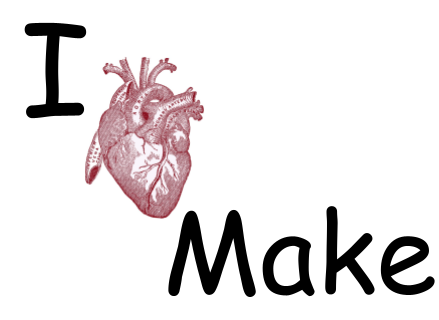I Heart Make
How to Convert CBR to PDF using a Makefile¶

Good news: I got a shiny new e-ink reader.
Bad news: It doesn't support CBR (Comic Book Reader) files.
Good news: I recently read the manual on make because I had trouble sleeping.
Bad news: It didn't put me to sleep.
Problem¶
I have a bunch of CBR (Comic Book Reader) files that I need to convert to PDF (Portable Document Format) files.
The general step for a single file would look something like:
rar x naruto-001.cbr .images # 1) unpack archive into .images/*.jpg
magick convert .images/* naruto-001.pdf # 2) convert all the images into pdf file
rm -rf .images # 3) remove the images.
But we're not here to convert a single file. We're here to convert a ton of them.
Without make, we could probably:
- extract the snippet to a bash script named
foo.sh - run the script on one file with
./foo.sh naruto-001.cbr - run the script on all the files with
find . -name '*.cbr' -exec ./foo.sh {} \;.
Then we'd curse when errors come up because:
- we forgot to make the script executable.
chmod +x foo.sh - we forget to add
-eso the script stops when something goes wrong.#!/bin/bash -e - something with
findnever works first try! - file
naruto-301.cbrfailed, and we don't want to runnaruto-{000-300}.cbragain!
Solution¶
Make way for make! A Makefile can handle most of our iteration problems automatically.
It already has the facilities to handle multiple files, error handling, and skipping finished files.
A Full Makefile¶
cbr_files = $(wildcard *.cbr)
pdf_files = $(cbr_files:.cbr=.pdf)
image_dir = .images-$<
all: ${pdf_files}
@echo All done
clean:
rm ${pdf_files}
%.pdf: %.cbr
@echo Building $< into $@
rar x $< ${image_dir}/
find ${image_dir}/ -size 0 -ls -delete
magick convert ${image_dir}/* $@
rm -rf ${image_dir}
@echo $@ is ready
Makefile with in-Line Comments¶
# 1. Get a list of all CBR files in the current directory
cbr_files = $(wildcard *.cbr)
# 2. Get a list of all PDFs I want to build by renaming CBR list to PDF
pdf_files = $(cbr_files:.cbr=.pdf)
# 3. Set where the unpacked images should go. We'll delete them after each build
image_dir = .images-$<
# 4. The first target specified is always the default when we run `make` without any arguments
all: ${pdf_files}
@echo All done
# 5. `make clean` will remove all the generated PDFs
clean:
rm ${pdf_files}
# 6. Use Pattern Rules to build an individual PDF file
%.pdf: %.cbr
# use @ to prevent `make` from printing the command it is executing
@echo Building $< into $@
# ^ ^
# | |
# | |
# | +- foo.pdf
# |
# +- foo.cbr
#
rar x $< ${image_dir}/
# ^ ^ ^
# | | |
# | | +- unpack to destination directory
# | |
# | +- foo.cbr
# |
# +- extract
#
find ${image_dir}/ -size 0 -ls -delete
# ^ ^ ^ ^
# | | | |
# | | | +- delete the file
# | | |
# | | +- print `ls -l` of the file
# | |
# | +- only files with zero size
# +- find in image directory
#
magick convert ${image_dir}/* $@
# ^ ^
# | |
# | +- foo.pdf
# |
# +- all files in image directory
#
rm -rf ${image_dir}
# ^
# |
# +- delete entire image director. We don't need it anymore.
#
@echo $@ is ready
Code the contents of either snippet into a Makefile and put the Makefile in the same directory as all the cbr files.
Then execute make and a pile of pdf files should get created.
If we run with make -j 4 it will even run multiple files in parallel where 4 is the number of parallel jobs you'd
like to run. Revel in the code we didn't have to write to enable parallelism!
A Little Deeper¶
The make magic occurs in step 6 with %.pdf: %.cbr.
This is officially called a pattern rule according to the documentation.
It tells make to build a target for any file suffixed with .pdf and set a dependency for the same file suffixed with .cbr.
With the pattern rule in place and using $< to represent the first dependency and $@ to represent the target file, we can script out the remaining build.
Another piece of magic is in step #3.
image_dir = .images-$< is a variable assignment referencing $<.
The = assignment operator in make is a macro, meaning it won't get evaluated until the variable is referenced in a target.
This can be surprising at first, but in this case, it provides a nice unique directory for our images to get unpacked.
More details about Makefile variable use can be found in their docs.
Conclusion¶
make isn't the shinest build system around.
Wikipedia says there are over 40 of them, but in my opinion, make get's the most value for the least amount of effort.
make provides dependency checking, multiple job support, and simple bash-like syntax without the need to npm install the_world.
Thanks for makeing it this far. Let me know how you make use of make in the comments below.